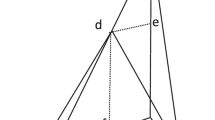Abstract
This paper draws the distinctions between the concepts of endogenous and exogenous comparative advantages and between the concepts of economies of specialization and scale. A comparison between the equilibrium model endogenizing the degree of specialization and endogenous comparative advantages, neoclassical trade model with exogenous comparative advantages, and an extended Dixit-Stiglitz model with a tradeoff between economies of scale and transaction costs is used to explore the equilibrium implications of the distinctions.
Similar content being viewed by others
References
Blanchard, O., and Kiyotaki, N. (1987): “Monopolistic Competition and the Effects of Aggregate Demand.”American Economic Review 77: 647–666.
Durkheim, E. (1964):The Division of Labor in Society, transl. with an introduction by G. Simpson. New York: Free Press.
Ethier, W. (1979): “Internationally Decreasing Costs and World Trade.”Journal of International Economics 9: 1–24.
Grossman, G., and Helpman, E. (1989): “Product Development and International Trade.”Journal of Political Economy 97: 1261–1283.
Houthakker, M. (1956): “Economics and Biology: Specialization and Speciation.”Kyklos 9: 181–189.
Krugman, P. (1979): “Increasing Returns, Monopolistic Competition, and International Trade.”Journal of International Economics 9: 469–479.
Marshall, A. (1920):Principles of Economics. London: Macmillan.
Ricardo, D. (1973):The Principle of Political Economy and Taxation. London: Gaernsey Press.
Romer, P. (1986): “Increasing Returns, Specialization, and External Economies: Growth as Described by Allyn Young.” Working Paper No. 64, Center for Economic Research, University of Rochester.
Rotemberg, J. (1987): “The New Keynesian Microfoundations.” InNBER Macroeconomics Annual 1987, edited by S. Fischer. Cambridge, MA: MIT Press.
Rosen, S. (1978): “Substitution and the Division of Labor.”Economica 45: 235–250.
— (1983): “Specialization and Human Capital.”Journal of Labor Economics 1: 43–49.
Smith, A. (1976):An Inquiry into the Nature and Causes of the Wealth of Nations, edited by E. Cannan. Chicago: University of Chicago Press.
Stigler, G. (1951): “The Division of Labor is Limited by the Extent of the Market.”Journal of Political Economy 59: 185–193.
Yang, X. (1988):An Approach to Modeling the Division of Labor Based on Increasing Returns to Specialization. Ph.D. Dissertation, Department of Economics, Princeton University, Princeton, NJ.
— (1990): “Development, Structural Changes, and Urbanization.”Journal of Development Economics 34: 199–222.
Yang, X., and Borland, J. (1991): “A Microeconomic Mechanism for Economic Growth.”Journal of Political Economy 99: 460–482.
Yang, X., and Heijdra, B. (1993): “Monopolistic Competition and Optimum Product Diversity: CommentAmerican Economic Review 83: 295–301.
Yang, X., and Ng, Y. (1994): “Theory of the Firm and Structure of Property Rights.”Journal of Economic Behaviour and Organization (forthcoming).
Yang, X., and Shi, H. (1992): “Specialization and Product Diversity.”American Economic Review 82: 392–398.
Yang, X., and Wills, I. (1990): “A Model Formalizing the Theory of Property Rights.”Journal of Comparative Economics 14: 177–198.
Young, A. (1928): “Increasing Returns and Economic Progress.”Economic Journal 152: 527–542.
Author information
Authors and Affiliations
Rights and permissions
About this article
Cite this article
Yang, X. Endogenous vs. exogenous comparative advantage and economies of specialization vs. economies of scale. Zeitschr. f. Nationalökonomie 60, 29–54 (1994). https://doi.org/10.1007/BF01228024
Received:
Revised:
Issue Date:
DOI: https://doi.org/10.1007/BF01228024




